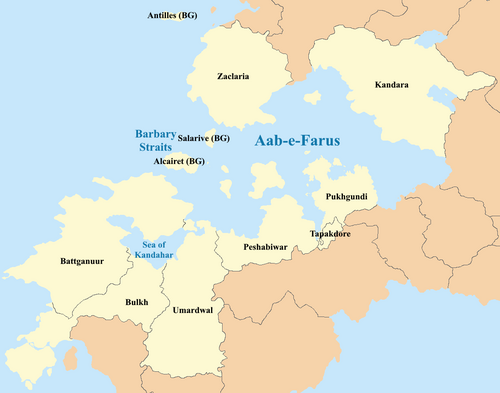Middle seas region: Difference between revisions
mNo edit summary Tag: 2017 source edit |
mNo edit summary Tag: 2017 source edit |
||
| (4 intermediate revisions by the same user not shown) | |||
| Line 1: | Line 1: | ||
{{stub}} | {{stub}} | ||
[[File:Middle_seas_region_political_map.png|500px|right|Map of the Middle seas region]] | |||
{{Business logistics}} | |||
The Middle seas region is the areas of eastern [[Audonia]] around the [[Aab-e-Farus]] and the [[Sea of Kandahar]] from which it gets its name. | |||
The Middle Seas region does not have legal status but is more of a cultural and economic generalization for the peoples and nations who are in close proximity to each other and are the typical trade partners and political allies or rivals of the other nations in the region. | |||
Throughout history, peoples, cultures, religions, and languages were constantly intermixing in the region. They were forced together through external forces like the [[Oduniyyad Caliphate]], the [[Burgoignesc colonial empire]], and the [[Caphiria]]n colonization of [[Zaclaria]]. Today the nations of the Middle seas region are totally sovereign and independent of each other, but they share some aspects in common. Many of them, as a vestige of the [[Burgoignesc colonial empire]], use the [[Burgoignesc language]] as their language of business and international politics. Some of them use currency pegged to the [[Taler#Pegged_currencies|Taler]]. And almost all have minority Christian populations dating back to the proselytization of the [[Bergendii]] and [[Caphiria]]ns. | |||
=Geographic extent= | |||
It includes the nations of [[Bulkh]], [[Umardwal]], [[Zaclaria]], [[Kandara]], [[Tapakdore]], [[Peshabiwar]], [[Pukhgundi]], the [[Burgundie|Burgoignesc]] island of [[Alcairet]], [[Antilles]], and [[Salarive]]. | |||
=Controversies= | |||
The nations of the Middle sea region are the ones most impacted and most vocal about [[Burgundie]]'s [[La Garrote]], as the ring of [[Burgundie]]'s overseas provinces exert disproportionate control on the trade and economies of the region. | |||
=See also= | |||
{{Audonia topics}} | |||
[[Category: Political Geography]] | [[Category: Political Geography]] | ||
[[Category: Cultural Geography]] | [[Category: Cultural Geography]] | ||
Latest revision as of 15:36, 3 April 2024
| This article is a stub. You can help IxWiki by expanding it. |

| Business logistics |
|---|
| Distribution methods |
| Management systems |
| Industry classification |
| Historical business logistics |
|
The Middle seas region is the areas of eastern Audonia around the Aab-e-Farus and the Sea of Kandahar from which it gets its name.
The Middle Seas region does not have legal status but is more of a cultural and economic generalization for the peoples and nations who are in close proximity to each other and are the typical trade partners and political allies or rivals of the other nations in the region.
Throughout history, peoples, cultures, religions, and languages were constantly intermixing in the region. They were forced together through external forces like the Oduniyyad Caliphate, the Burgoignesc colonial empire, and the Caphirian colonization of Zaclaria. Today the nations of the Middle seas region are totally sovereign and independent of each other, but they share some aspects in common. Many of them, as a vestige of the Burgoignesc colonial empire, use the Burgoignesc language as their language of business and international politics. Some of them use currency pegged to the Taler. And almost all have minority Christian populations dating back to the proselytization of the Bergendii and Caphirians.
Geographic extent
It includes the nations of Bulkh, Umardwal, Zaclaria, Kandara, Tapakdore, Peshabiwar, Pukhgundi, the Burgoignesc island of Alcairet, Antilles, and Salarive.
Controversies
The nations of the Middle sea region are the ones most impacted and most vocal about Burgundie's La Garrote, as the ring of Burgundie's overseas provinces exert disproportionate control on the trade and economies of the region.